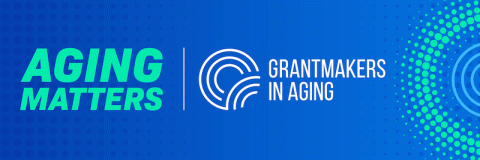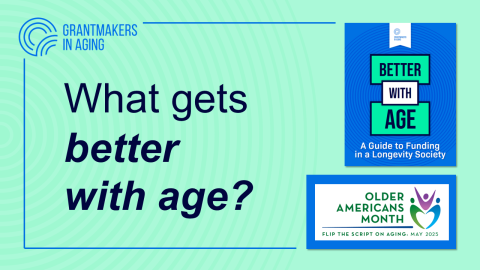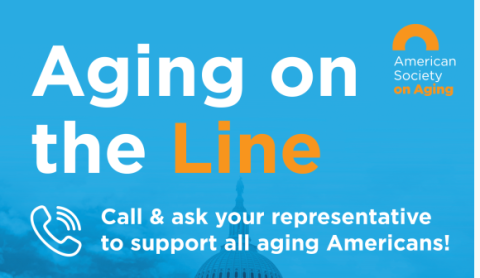
A Message from Lindsay Goldman
Read the full May 2025 edition of Aging Matters
I enjoy Older Americans Month and appreciate the 2025 theme, “Flip the Script,” about challenging aging stereotypes. At GIA, we’re doing that by asking “What gets better with age?” on social media. The answers have been creative and funny. We’re doing it all month, so add your answers in the comments of our LinkedIn post.
(We all think a lot of things - beyond the usual wine and cheese - get better with age, including boots, hairstyles, and relationships, to name a few. See why philanthropy also gets Better with Age in our Guide to Funding in a Longevity Society.)

Unfortunately, most aging news this month has not been funny. If proposed federal cuts succeed, some of the most essential and effective aging services would be eliminated. Just to name a few: the Aging and Disability Resource Centers (ADRCs), which help people with one of the scariest aspects of aging – finding long-term care. And the Medicare State Health Insurance Assistance Program (SHIP) – the only truly objective source of advice on the bewildering job of picking the right Medicare plan.
Then there’s Lifespan Respite Care. On average, family caregivers provide 24 hours of care a week for more than 4 years, often at the expense of their own physical, mental, and financial health. Without respite, caregivers burn out. Respite utilization is associated with reduced hospitalization and delayed institutionalization, both of which are cost-saving.
The Low-Income Home Energy Assistance Program (LIHEAP) – also slated for elimination – helps with heating and cooling affordability, which is critical for older people, who are disproportionately at risk of both heat- and cold-related illness and death. Heat-related illness costs as much as $1 billion in healthcare expenses each summer, and heat-related deaths of those age 65 and older have increased by nearly 54 percent in the last 20 years. On the flip side, lower heating costs reduce winter mortality. The National Council on Aging offers this excellent summary for more on what’s been proposed.
And let’s not forget the very real possibility of deep Medicaid cuts that would leave at least 13.7 million people uninsured and make Medicare affordability and long-term care access even worse than they are now.
Doing less with less
Whatever you fund, you’re probably thinking about how your organization can help fill gaps that may be getting a lot bigger soon.
That may be getting harder, because your foundation’s taxes may be going up. The proposed budget reconciliation bill calls for increasing excise taxes on foundation endowments over $50 million, as much as tenfold. Other measures would make corporate philanthropy less attractive tax-wise. (Details at Exponent Philanthropy.)
Philanthropic umbrella associations, including the Council on Foundations, United Philanthropy Forum, and Philanthropy Roundtable, are advocating against these proposals. Council on Foundations is collecting stories of how higher taxes will reduce grantmaking to communities (contribute yours here).
From people outside our sector, I frequently hear the view that philanthropy can and should step up in this crisis. I agree, and there are things we can do that will make a difference. But let’s be clear: philanthropy will not be able to replace the infrastructure and resources the government has provided for decades. One analysis found that “private foundations would have to nearly triple their grantmaking beyond the estimated $107 billion a year they currently move to nonprofits.” A significantly higher excise tax makes this even more unlikely.
It’s not over yet
Many funders try to keep their institutions out of the political fray. But some advocacy by 501(c)(3) organizations is allowed (see our webinar here) and as individuals, everyone has the right to tell their elected representatives what they think.

In this pivotal moment, GIA and Grantmakers In Health are co-sponsoring Aging on the Line to help you do that. In partnership with National Alliance for Caregiving and the American Society on Aging, Aging on the Line provides sample scripts for calls and emails and helps you find contact information specifically for your representatives.
Elder justice?
Earlier, I mentioned several aging programs that are at risk. I’d like to add one more. The budget for preventing elder abuse is slated to be cut to just $5 million. The Long-Term Care Ombudsman Program (which helps people being abused or exploited in nursing homes and uses more than twice as many volunteers as paid staff) as well as Adult Protective Services and other elder abuse, neglect, and exploitation efforts would all be eliminated.
One in ten older people experiences physical abuse or financial exploitation every year, even with current safeguards.
Now that we’ve seen something, isn’t it time to say something?